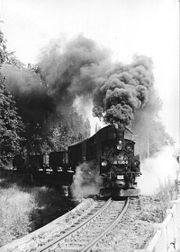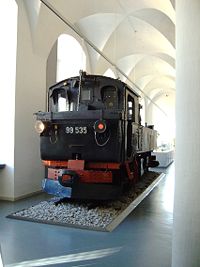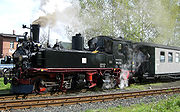
Saxon IV K
Encyclopedia
The Saxon IV K were eight-wheeled, narrow gauge, Günther-Meyer type
steam engines built for the Royal Saxon State Railways
with a rail gauge
of 750 mm. A total of 96 were built between 1892 and 1921, making the Saxon IV K the most numerous narrow gauge locomotive in Germany. In 1925 the Deutsche Reichsbahn
grouped these engines into their DRG Class 99.51–60.
developed an engine with eight coupled wheels and which had a larger boiler
and adhesive weight
. Unlike its predecessors, it was given two driven bogies in order to be able to cope with winding routes despite its length.
Between 1892 and 1921 a total of 96 locomotives were built with running numbers 103 to 198. To begin with they were designated as class H M T K V, which meant that they were locomotives built by Hartmann
(H) to a Meyer design (M) as a tank engine (T) with a 750mm rail gauge
(K) and compound engine (V). From 1896 they were reclassified as K IV and from 1900 as IV K. The 'K' stood for Kleinspur or 'small gauge'.
The IV K was used both in front of passenger trains and also goods trains and proved itself so well that it ousted the other locomotive classes completely on several lines.
Five examples has to be handed over to Poland
as reparations
after the First World War. In 1925 the Deutsche Reichsbahn-Gesellschaft
took over the remaining 91 units allocating them the numbers 99 511–546, 99 551–558, 99 561–579 and 99 581–608.
 From the 1930s onwards the oldest engines were retired. After the Second World War there were still 57 working locomotives of this class on Saxon railways. Nine locomotives later went to the Rügen Kleinbahn and to the Prignitz district Kleinbahnen, where they were fitted with Knorr brakes and in conjunction with that an impressive air reservoir on the boiler.
From the 1930s onwards the oldest engines were retired. After the Second World War there were still 57 working locomotives of this class on Saxon railways. Nine locomotives later went to the Rügen Kleinbahn and to the Prignitz district Kleinbahnen, where they were fitted with Knorr brakes and in conjunction with that an impressive air reservoir on the boiler.
The DR planned to replace them with the Neubau diesel locomotives of DR Class V 36.48. However because trials with the two prototypes were not promising, 20 of the former Saxon engines underwent extensive modernisation in 1962. To begin with the locomotives were given new welded boilers, and later a new welded locomotive frame
as well. External identification marks of the upgraded locomotives are the missing sandbox on the boiler and the flatter steam dome
cover.
By 1973 the last unmodernised locomotives had been retired from duty. Locomotives 99 535 (Dresden Transport Museum
), 99 579 (Museum Rittersgrün) und 99 604 (DGEG
, today SSB Radebeul), still in their original design, were secured for museum purposes.
The retirement of the reconstructed locomotives did not begin until the mid-1970s, starting with those engines that still had their original rivetted frames.
In 1991 there were only 13 IV K left in the operational fleet of the Deutsche Reichsbahn. In the wake of the merger of the running numbers of the DR and DB
these engines were given the new numbers 099 701 to 099 713 on 1 January 1992. Several locomotives were however already sold to railway societies, so that not all of the engines displayed their newly allocated numbers.
Some locomotives ended up on 1 January 1994 in the Deutsche Bahn AG, but from that point on they were no longer used in scheduled services.
–Jöhstadt
und Oschatz
–Mügeln
–Kemmlitz lines.


 22 locomotives of Saxon Class IV K remain preserved today, the majority being operational. In addition to the Saxon museum railway groups the Saxon Steam Railway Company
22 locomotives of Saxon Class IV K remain preserved today, the majority being operational. In addition to the Saxon museum railway groups the Saxon Steam Railway Company
(formerly BVO Bahn) and the Döllnitzbahn GmbH employ IV K engines for special duties hauling museum trains.
Meyer locomotive
A Meyer locomotive is a type of articulated locomotive. The design was never as popular as the Garratt or Mallet locomotives. It can be best regarded as 19th Century competition for the early compound Mallet and also the Fairlie articulated designs....
steam engines built for the Royal Saxon State Railways
Royal Saxon State Railways
The Royal Saxon State Railways were the state-owned railways operating in the Kingdom of Saxony from 1869 to 1918...
with a rail gauge
Rail gauge
Track gauge or rail gauge is the distance between the inner sides of the heads of the two load bearing rails that make up a single railway line. Sixty percent of the world's railways use a standard gauge of . Wider gauges are called broad gauge; smaller gauges, narrow gauge. Break-of-gauge refers...
of 750 mm. A total of 96 were built between 1892 and 1921, making the Saxon IV K the most numerous narrow gauge locomotive in Germany. In 1925 the Deutsche Reichsbahn
Deutsche Reichsbahn
Deutsche Reichsbahn was the name of the following two companies:* Deutsche Reichsbahn, the German Imperial Railways during the Weimar Republic, the Third Reich and the immediate aftermath...
grouped these engines into their DRG Class 99.51–60.
History
As a result of the constantly rising traffic on the Saxon narrow gauge railways towards the end of the 19th century, the power of the existing Saxon I K and III K soon proved insufficient. So the Sächsische MaschinenfabrikSächsische Maschinenfabrik
The Sächsische Maschinenfabrik in Chemnitz was one of the most important engineering companies in Saxony in the second half of the 19th century and the first two decades of the 20th century. Including its various predecessor businesses, the firm existed from 1837 until its liquidation in 1930, and...
developed an engine with eight coupled wheels and which had a larger boiler
Boiler
A boiler is a closed vessel in which water or other fluid is heated. The heated or vaporized fluid exits the boiler for use in various processes or heating applications.-Materials:...
and adhesive weight
Adhesive weight
Adhesive weight is the amount of a locomotive's weight that is applied to the driving wheels and so capable of delivering traction. The more weight applied to the driving wheels, the greater the locomotive's ability to haul a load. But if the weight on the driving wheels exceeds the axle load of...
. Unlike its predecessors, it was given two driven bogies in order to be able to cope with winding routes despite its length.
Between 1892 and 1921 a total of 96 locomotives were built with running numbers 103 to 198. To begin with they were designated as class H M T K V, which meant that they were locomotives built by Hartmann
Hartmann
Hartmann is a surname and may refer to:- People :* Erich Hartmann , German fighter ace* Ernst Hartmann , German medical doctor, author and publicist* Felix von Hartmann , Cardinal Archbishop of Köln...
(H) to a Meyer design (M) as a tank engine (T) with a 750mm rail gauge
Rail gauge
Track gauge or rail gauge is the distance between the inner sides of the heads of the two load bearing rails that make up a single railway line. Sixty percent of the world's railways use a standard gauge of . Wider gauges are called broad gauge; smaller gauges, narrow gauge. Break-of-gauge refers...
(K) and compound engine (V). From 1896 they were reclassified as K IV and from 1900 as IV K. The 'K' stood for Kleinspur or 'small gauge'.
The IV K was used both in front of passenger trains and also goods trains and proved itself so well that it ousted the other locomotive classes completely on several lines.
Five examples has to be handed over to Poland
Poland
Poland , officially the Republic of Poland , is a country in Central Europe bordered by Germany to the west; the Czech Republic and Slovakia to the south; Ukraine, Belarus and Lithuania to the east; and the Baltic Sea and Kaliningrad Oblast, a Russian exclave, to the north...
as reparations
World War I reparations
World War I reparations refers to the payments and transfers of property and equipment that Germany was forced to make under the Treaty of Versailles following its defeat during World War I...
after the First World War. In 1925 the Deutsche Reichsbahn-Gesellschaft
Deutsche Reichsbahn-Gesellschaft
The Deutsche Reichsbahn – was the name of the German national railway created from the railways of the individual states of the German Empire following the end of World War I....
took over the remaining 91 units allocating them the numbers 99 511–546, 99 551–558, 99 561–579 and 99 581–608.

The DR planned to replace them with the Neubau diesel locomotives of DR Class V 36.48. However because trials with the two prototypes were not promising, 20 of the former Saxon engines underwent extensive modernisation in 1962. To begin with the locomotives were given new welded boilers, and later a new welded locomotive frame
Locomotive frame
A locomotive frame is the structure that forms the backbone of the railway locomotive, giving it strength and supporting the superstructure elements such as a cab, boiler or bodywork. The vast majority of locomotives have had a frame structure of some kind...
as well. External identification marks of the upgraded locomotives are the missing sandbox on the boiler and the flatter steam dome
Steam dome
A Steam dome is a vessel fitted to the top of the boiler of a steam locomotive. It contains the opening to the main steam pipe and its purpose is to allow this opening to be kept well above the water level in the boiler...
cover.
By 1973 the last unmodernised locomotives had been retired from duty. Locomotives 99 535 (Dresden Transport Museum
Dresden Transport Museum
The Dresden Transport Museum displaysvehicles of all modes of transport, such as railway, shipping, road and air traffic, under one roof.The museum is housed in the Johanneum at the Neumarkt in Dresden, Germany...
), 99 579 (Museum Rittersgrün) und 99 604 (DGEG
DGEG
The German Railway History Company or DGEG is a society concerned with the history of the railways...
, today SSB Radebeul), still in their original design, were secured for museum purposes.
The retirement of the reconstructed locomotives did not begin until the mid-1970s, starting with those engines that still had their original rivetted frames.
In 1991 there were only 13 IV K left in the operational fleet of the Deutsche Reichsbahn. In the wake of the merger of the running numbers of the DR and DB
Deutsche Bundesbahn
The Deutsche Bundesbahn or DB was formed as the state railway of the newly established Federal Republic of Germany on September 7, 1949 as a successor of the Deutsche Reichsbahn-Gesellschaft '...
these engines were given the new numbers 099 701 to 099 713 on 1 January 1992. Several locomotives were however already sold to railway societies, so that not all of the engines displayed their newly allocated numbers.
Some locomotives ended up on 1 January 1994 in the Deutsche Bahn AG, but from that point on they were no longer used in scheduled services.
Duties
Over the course of time the Saxon IV K locomotives were deployed to all Saxon narrow gauge lines. Even in the 1980s these engines were handling all the traffic on the WolkensteinWolkenstein
Wolkenstein is a town in the district Erzgebirgskreis, in the Free State of Saxony, Germany. It is situated in the Ore Mountains, on the Zschopau River, 22 km southeast of Chemnitz....
–Jöhstadt
Jöhstadt
Jöhstadt is a town in the district of Erzgebirgskreis, in the Free State of Saxony, Germany. It is situated in the Ore Mountains, on the border with the Czech Republic, 10 km southeast of Annaberg-Buchholz, and 35 km northeast of Karlovy Vary....
und Oschatz
Oschatz
Oschatz is a town in the district Nordsachsen, in the Free State of Saxony, Germany. It is located 60 km east of Leipzig and 60 km west of Dresden.- Site and Climate :...
–Mügeln
Mügeln
Mügeln is a town in the district Nordsachsen, in the Free State of Saxony, Germany. It is located 9 km southwest of Oschatz and 14 km northwest of Döbeln. The town has a population of approximately 4700 people.- Geography :...
–Kemmlitz lines.
Preserved locomotives



Saxon Steam Railway Company
The Saxon Steam Railway Company , formerly the BVO Bahn, is a German railway company in Saxony, that operates several Saxon narrow gauge railways...
(formerly BVO Bahn) and the Döllnitzbahn GmbH employ IV K engines for special duties hauling museum trains.
- 99 516 – Museumsbahn Schönheide (working)
- 99 534 – Monument locomotive in GeyerGeyerGeyer is a town in the district of Erzgebirgskreis, in Saxony, Germany. It has a population of about 4000.- Geography :Geyer is situated northwest of Annaberg-Buchholz, and south of Chemnitz, in the valley of the Geyersbach creek...
- 99 535 – Dresden Transport MuseumDresden Transport MuseumThe Dresden Transport Museum displaysvehicles of all modes of transport, such as railway, shipping, road and air traffic, under one roof.The museum is housed in the Johanneum at the Neumarkt in Dresden, Germany...
- 99 539 – Traditionsbahn Radebeul
- 99 542 – Preßnitztalbahn (working)
- 99 555 – Zittauer Schmalspurbahnen e.V. (being restored)
- 99 561 – Förderverein Wilder Robert (working)
- 99 562 – German Steam Locomotive MuseumGerman Steam Locomotive MuseumThe German Steam Locomotive Museum or DDM is located at the foot of the famous Schiefe Ebene ramp on the Ludwig South-North Railway in Neuenmarkt, Upper Franconia. This region is in northern Bavaria, Germany...
, Neuenmarkt-Wirsberg - 99 564 – Saxon Steam Railway CompanySaxon Steam Railway CompanyThe Saxon Steam Railway Company , formerly the BVO Bahn, is a German railway company in Saxony, that operates several Saxon narrow gauge railways...
(working) - 99 566 – Saxon Railway MuseumSaxon Railway MuseumThe Saxon Railway Museum is located in Chemnitz, in the state of Saxony, eastern Germany. It is situated on the site of the former locomotive depot for goods train locomotives in the district Hilbersdorf.After the locomotive depot was closed in 1992, the society moved into the buildings which...
, Chemnitz - 99 568 – Preßnitztalbahn (working)
- 99 574 – DöllnitzbahnDöllnitzbahnThe Döllnitzbahn GmbH is a private railway company in Saxony in eastern Germany. It is the operator of the Oschatz–Mügeln–Kemmlitz/Glossen narrow gauge line in central Saxony.-History:...
(working) - 99 579 – Schmalspurbahnmuseum Rittersgrün
- 99 582 – Museumsbahn Schönheide (working)
- 99 584 – Rügen Railway & Technology MuseumRügen Railway & Technology MuseumThe Rügen Railway and Technology Museum is a German railway museum based on the Baltic Sea island resort of Rügen in the state of Mecklenburg-Western Pomerania, Germany...
, ProraProraProra is a beach resort on the island of Rügen, Germany, known especially for its colossal Nazi-planned touristic structures. The massive building complex was built between 1936 and 1939 as a Kraft durch Freude project. The eight buildings are identical, and while they were planned as a holiday... - 99 585 – Museumsbahn Schönheide
- 99 586 – Traditionsbahn Radebeul
- 99 590 – Preßnitztalbahn (working)
- 99 594 – Rügensche Kleinbahn (working)
- 99 604 – Verein zur Förderung Sächsischer Schmalspurbahnen e.V. (SSB Radebeul)
- 99 606 – Verein zur Förderung Sächsischer Schmalspurbahnen e.V. (Carlsfeld)
- 99 608 – Saxon Steam Railway Company (working)
Literature
- Fischer, Rainer 104 Jahre unterwegs. 99 539, Lok-Magazin, No. 261, 2003, GeraNova, München, ISSN 0458-1822, pp. 54–59
- Lenhard, Dirk, Moll, Gerhard and Scheffler, Reiner. Die sächsische IV K, EK-Verlag, Freiburg, 2004, ISBN 3-88255-199-2
External links
- Vehicles of the IG Preßnitztalbahn e.V.
- Vehicles of the Mügelner Schmalspurnetz
- Technical data and photos of historical locos (German)
- There is a relevant English-language forum at Railways of Germany

